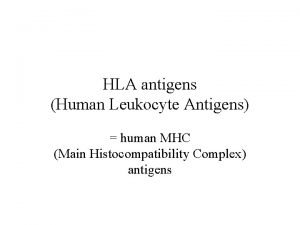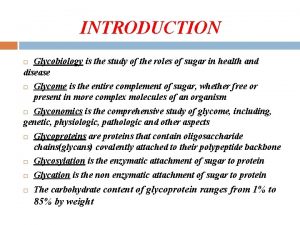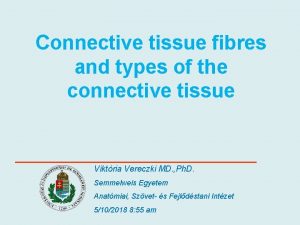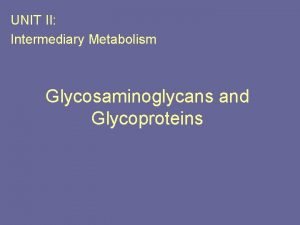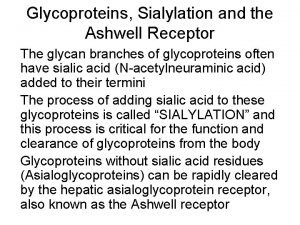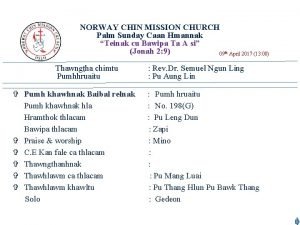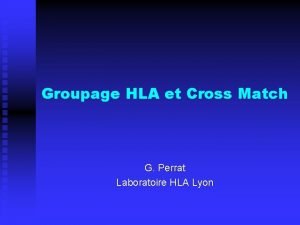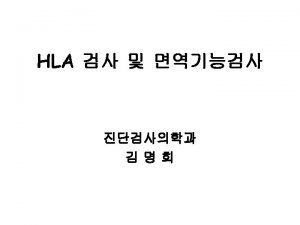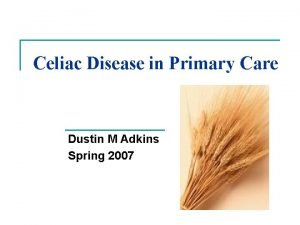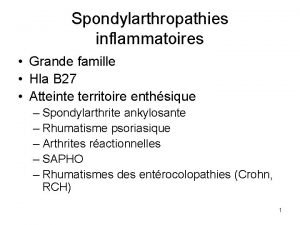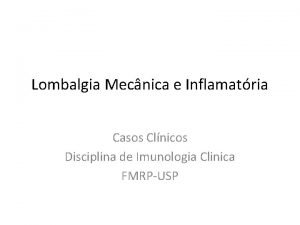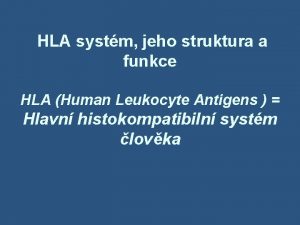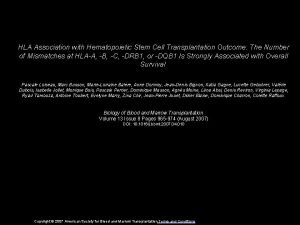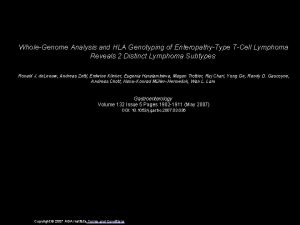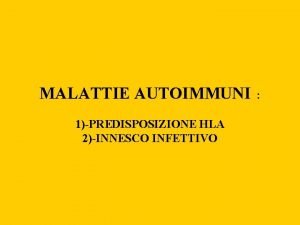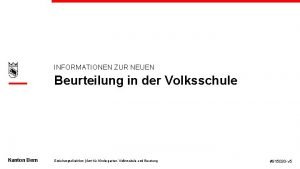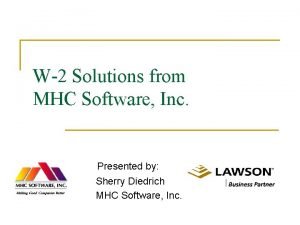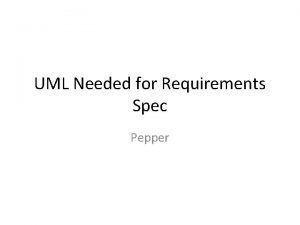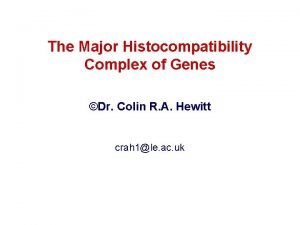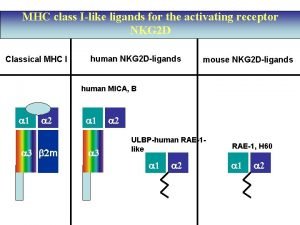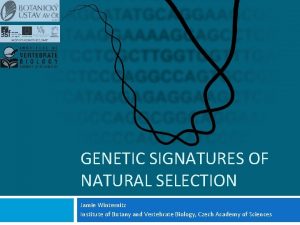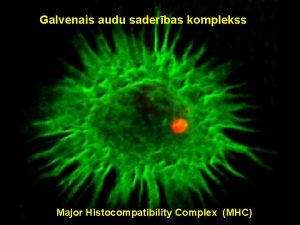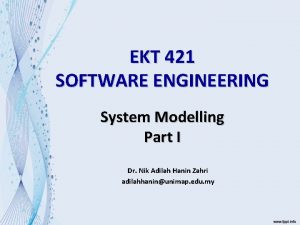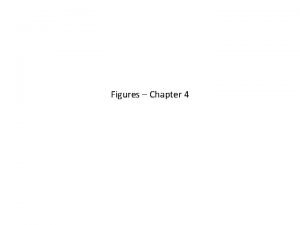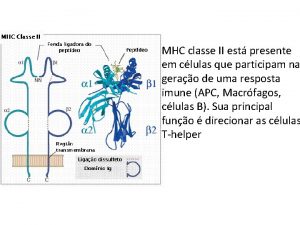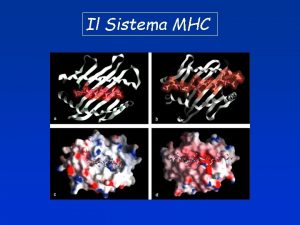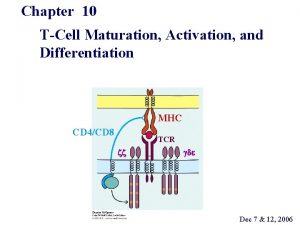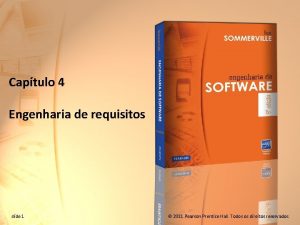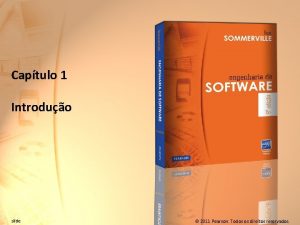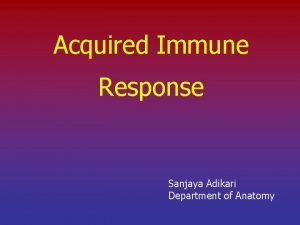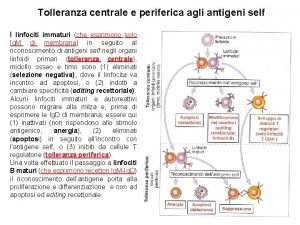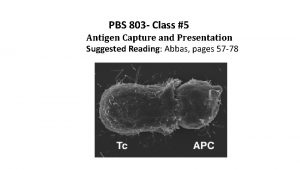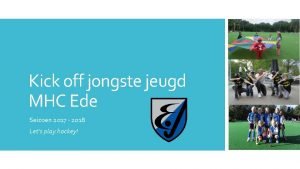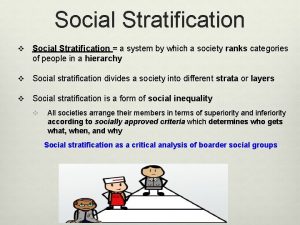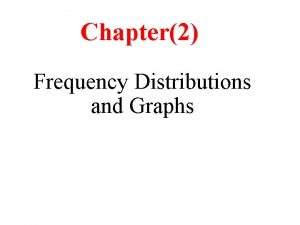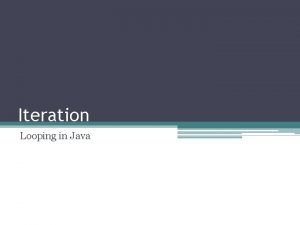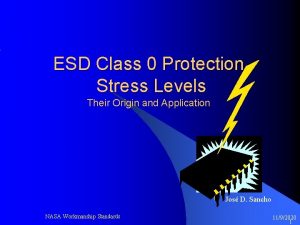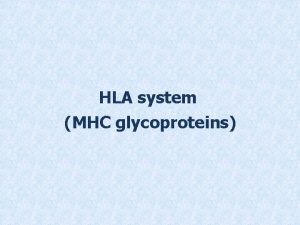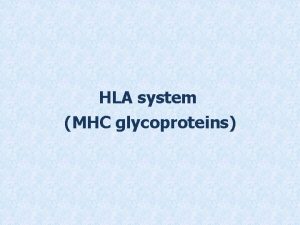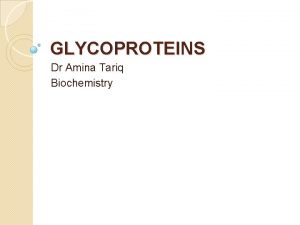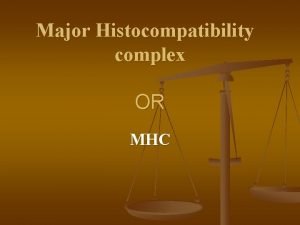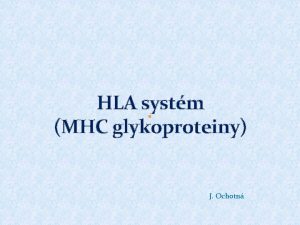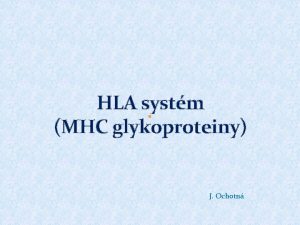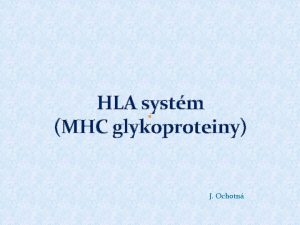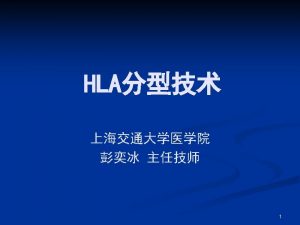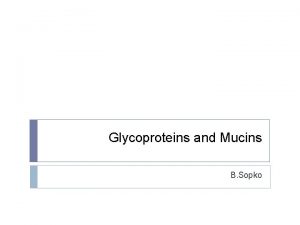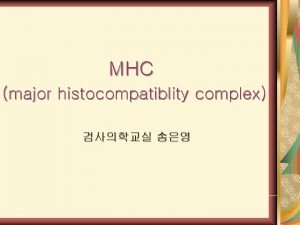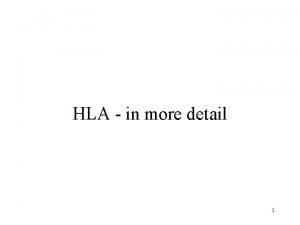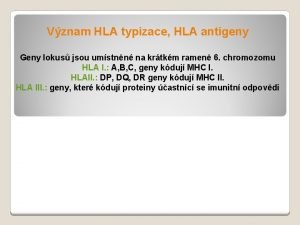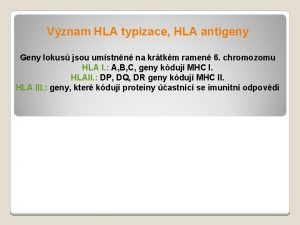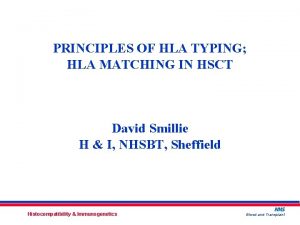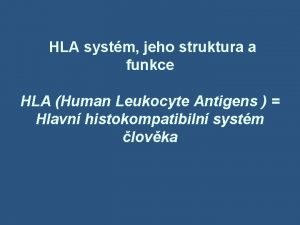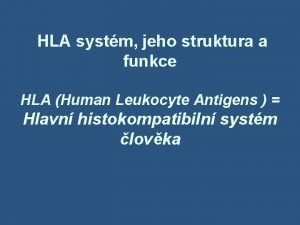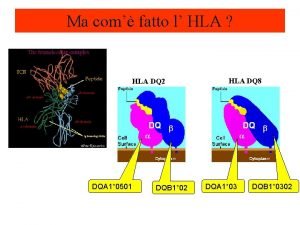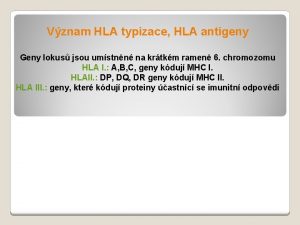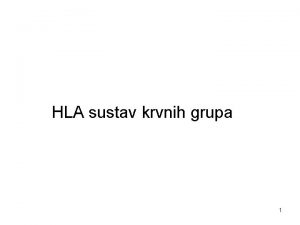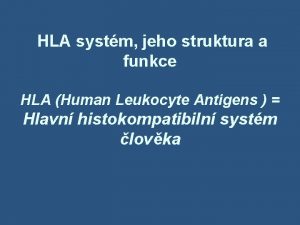HLA system MHC glycoproteins MHC glycoproteins class I

























































- Slides: 57

HLA system (MHC glycoproteins)

MHC glycoproteins class I (Major histocompatibility complex) § MHCgp. I present peptide fragments from itracellular proteins (which are produced by cell, including viral peptides if are present) on the cell surface for cytotoxic T lymphocytes ( CD 8+) § Expressed on all nucleated cells § 3 isotypes of classical MHC gp. (HLA - A, -B, -C) § 3 isotypes non-classical MHC gp. (HLA - E, -F, -G; molecule CD 1)

MHC gp I structure § MHC gp class I consists of transmembrane chain a and associated b 2 microglobulin § a 1, a 2 - binding site for peptides § Peptide binding is necessary for a stable conformation of MHC gp

MHC gp. I peptide binding § MHC gp I binds peptides long 8 - 10 amino acids § Certain MHC gp molecule binds peptides sharing identical structural features binding motif § The binding of endogenous peptides occurs in the endoplasmic reticulum during biosynthesis of MHC gp I § These peptides are produced from intracellular proteins that are cleaved by the proteasomes

MHC gp. I peptide binding

Non-classical MHC gp I § HLA - E, -F, -G; CD 1 molecules § Structurally similar to classical MHC gp § Less polymorphic § Expressed only on some cells § They specialize in binding of specific ligands

Non-classical MHC gp I § HLA-E and HLA-G - expressed on the trophoblast cells § Complexes of HLA-E and HLA-G with peptides are recognized by NK cells inhibitory receptors and contribute to the tolerance of the fetus in utero

MHC glycoproteins class II § MHC gp. II present peptide fragments from extracellular proteins on the cell surface for helper T lymphocytes (CD 4+) § Expressed on the APC (dendritic cells, monocytes, macrophages, B lymphocytes) § 3 isotypes of MHC gp. II (DR, DQ, DP)

MHC gp II structure § MHC gp II consist of 2 associated transmembrane chains a and b § a 1, b 1 - binding site for peptide § Peptide binding is necessary for a stable coformation of MHC gp and ensure its long presentation on the cell surface

MHC gp II peptide binding § MHC gp II binds peptides long 15 - 35 amino acids § Certain MHC gp molecule binds peptides sharing identical structural features –binding motif § Invariant chain blocks the binding site for the peptide § Exogenous peptides binds to MHC gp II in the endosome § Peptide fragments from endocytosed extracellular proteins

MHC gp II peptide binding

Antigen prezentation An antigen-presenting cell (APC) process foreign antigens and present them complexed with MHC‘s on their surfaces to T cells.

MHC glycoproteins polymorphism § HLA complex is located on chromosome 6 § For MHC gp is typical high polymorphism (hundreds of different alelic forms of isotypes) § Codominant inheritance of alelic forms

MHC glycoproteins polymorphism § Increases resistance to disease § Causes complications in the organ transplantation § Association of certain alleles with autoimmune diseases and increased susceptibility to infections

HLA typing = determmination of HLA antigens on the surface of lymphocytes § Carry out during the testing before transplantation and in determination of paternity § serotyping § genotyping

Serotyping (microlymfocytotoxic test) § Allospecific serums (obtained from multiple natal to 6 weeks after birth, or commercially prepared sets of typing serums (monoclonal antibodies)) § Principle - the incubation of lymphocytes with typing serums in the presence of rabbit complement, then is added the vital dye which stained dead cells - cells carrying specific HLA are killed by cytotoxic Ab against the Ag, the percentage of dead cells is a measure of serum toxicity (forces and antileukocyte antibody titre) § In positive reaction is more than 10% dead cells (serological typing can be done also by flow cytometry)

Serotyping (microlymfocytotoxic test)

Molecular genetic methods - genotyping a) PCR-SSP (Polymerase chain reaction with sequential specific primers) § Extracted DNA is used as a substrate in a set of PCR reactions § Each PCR reaction contains primers pair specific for a certain allele (or group of alleles) § Positive and negative reactions are evaluated by electrophoresis

Molecular genetic methods - genotyping b) PCR-SSO § PCR reaction with sequence-specific oligonucleotides § Hybridization with enzyme or radiolabeled oligonucleotides probes specific for individual alleles

Molecular genetic methods - genotyping c) PCR-SBT § Sequencing based typing § We get the exact sequence of nucleotides, which compares with a database of known sequences of HLA alleles

T cells

T cells § Cellular component of antigen-specific mechanisms § Several subsets of T lymphocytes (TH 1, TH 2, Treg, TC…) § Regulation of immune processes and destruction of virus-infected cells or tumor cells § TCR recognize peptide-MHC complex § T cell are activated by APC

T cell development § T cells originate in bone marrow and then migrate to the thymus where they mature (ab. T lymphocytes), the final differentiation is after activation by antigen processed and presented by APC § gd. T cells can develop outside thymus (the minority population) § T cells are after activation stimulated to proliferation and differentiation into effector cells and memory cells

T cell development

T cell development Pluripotent hematopoietic stem cells Pro-thymocytes – double negative T cells - are coming from the bone marrow to the thymus, where they begin to rearrange TCRb genes, express on their surface pre-TCR (Composed of b chain, pre-TCRa and CD 3 complex), then begin TCRa genes rearrangement Cortical thymocytes – double positive T cells - express on their surface TCR (composed of chains a, b and CD 3) and CD 4 and CD 8 co-receptor (double positive T lymphocyte), selection of the cells with dysfunctional TCR and autoreactive cells Medullary thymocytes (mature T cell) - retain the expression of CD 4 or CD 8, then migrate to secondary lymphoid organs

T cell selection § Positive selection - the elimination of cells with dysfunctional TCR, thymocytes that recognize MHC gp with low affinity are positively selected, then maintain the expression of CD 4 or CD 8 (depending which class of MHC gp binds to the TCR). § Negative selection - the elimination of autoreactive cells, which strongly bind MHCgp with normal peptides (autoantigens) which are expressed on the surface of thymic cells § 98% of pro-thymocytes in the thymus during its development dies § Mature T cells (Medullary thymocytes) leave thymus and migrate to secondary lymphoid organs

T cell selection

T cell surface markers § TCR - recognizes Ag peptide bound to MHC molecule § CD 3 - TCR component, participates in signal transduction § CD 4 or CD 8 - co-receptors, bind to MHC gp § CD 28 - costimulatory receptor, binds to CD 80, CD 86 on APC § CTLA-4 (CD 152) - inhibitory receptor, binds to CD 80, CD 86

Interaction between APC and T cell

T cell subpopulations § ab-T lymphocytes - have TCRab, major type (95 -98%), need thymus for development, recognize peptide antigens in the complex with MHC gp § gd-T lymphocytes - (2 -5%) may develop outside thymus, some are able to recognize native Ag, apply in defense of the skin and mucous membranes

CD 4+ T cells Express the CD 4 coreceptor (co-receptor for MHC class II gp), TCRab, precursors of helper T cells (TH), TH differentiate to several subtypes, which secret different cytokines TH 0 - produce a mixture of cytokines such as TH 1 and TH 2 TH 1 - IL-2, IFNg (activates macrophages ) TH 2 - IL-4, IL-5, IL-6, IL-10 (B lymphocytes assistance) TH 3 – TGFb Treg - regulatory T cells arise in the thymus from a part of autoreactive lymphocytes, suppress the activity of autoreactive T cell clones (IL-10, TGFb)

CD 8+ T cells Expressing the CD 8 co-receptor (co-receptor for MHC gp I), TCRab, precursors of cytotoxic T cells (TC) TC – recognize and destroy virus –infected cells or the cells infected with other intracellular parasites and some cancer cells

TCR § TCR (T cell receptor) is heterodimer consisting of a and b (g, d) chains § associated with CD 3 complex, which is necessary for signal transduction § N-terminal parts of a and b (g, d) chains form the binding site for Ag

T cell activation § T cell are activated by APC (DC, monocyte, macrophage, B cell) § TCR recognize peptide-MHC complex § TCR cooperate with coreceptors CD 4 (binds to MHC gp II) or CD 8 (binds to MHC gp I)

T cell activation § For full activation are necessary 2 signals § The first signal : TCR binding to peptide-MHC complex § The second signal comes from T cell co-stimulatory receptor CD 28 which binds to CD 80, CD 86 on APC § Without costimulation, the T cell becomes anergic (prevention of inappropriate responses to self-peptides)

T cell activation 1. Signal: TCR – MHC gp I(II)+Ag peptid (APC) 2. Co-stimulating signal: CD 28 (T lymphocyte) – CD 80, CD 86 (APC)

TCR cooperation with co-receptors CD 4, CD 8

Antigen-specific mechanisms

TH 1 based immune response

TH 1 based immune response - inflammatory reaction § TH 1 cells cooperate with macrophages and activate them (NO production - destroy intracellular parasites) § Activated macrophages secrete some cytokines (IL-1, TNF, . . . ) that help to stimulate T cells and stimulate local inflammation, which helps suppress infection § Interaction between TH 1 cells and macrophages is a fundamental mechanism of delayed-type immunopathological reactions (DTH Delayed-type hypersensitivity)

TH 1 based immune response § The infected macrophage produces protein fragments derived from intracellular parasites, some of which are presented on the surface in the complex with MHC gp class II § Macrophages and dendritic cells stimulated by certain microorganisms produce IL-12 § TH precursor, which detects the infected macrophage and receives signals via the TCR, CD 28 and receptor for IL-12 proliferates and differentiates into effector TH 1 cells that produce IFNg and IL-2. § IFNg activates macrophage NO synthase IL-2 is growth factor for T cells

Interaction between APC and TH precursor


TH 2 based immune response

TH 2 based immune response § TH 2 cells cooperate with B lymphocytes (which were stimulated by Ag) by cytokine production (IL-4, IL-5, IL-6, IL-10) and direct intercellular contact (CD 40 L) § For stimulation of B lymphocytes is usually necessary cooperation between APC → TH 2 cell → B lymphocyte § In minimal model, where the B cell becomes a good APC (CD 80, CD 86) is sufficient cooperation between TH 2 cell → B lymphocyte

TH 2 based immune response • TH precursor, which detects the infected macrophage and receives signals through the TCR, CD 28 , IL-4 receptor and IL-2 receptor proliferates and differentiates in the effector TH 2, which provide B lymphocytes auxiliary signals via secreted cytokines IL-4, IL-5, IL-6, IL-10 and molecule CD 40 L, which bind to the costimulatory receptor on B lymphocytes CD 40

TH 2 based immune response § Interaction between CD 40 (B lymphocytes) and CD 40 L (TH 2 cells) is essential for the initiation of somatic mutations, izotype switching and formation of memory cells § IL-4, IL-5, IL-6, IL-10: stimulation of B lymphocytes

Function of TH 2 cells

Mutual regulation of activities TH 1 versus TH 2 § Whether the TH precursor cell will develop into TH 1 or TH 2 decides cytokine ratio of IL-12 and IL-4 § IL-12 is produced by macrophages and dendritic cells stimulated by certain microorganisms § IL-4 is produced by activated basophils, mast cells and TH 2 cells § TH 1 cytokines (mainly IFNg) inhibit the development of TH 2 and stimulate the development of TH 1 (IL-2 stimulates also TH 2) § Cytokines produced by TH 2 (IL-4, IL-10) inhibit the development of TH 1 and stimulate the development of TH 2


TC based immune response

Cytotoxic T lymphocytes stimulation § TC recognize cells infected with viruses or other intracellular parasites, and some tumor cells § Precursor of TC, which recognizes a peptide-MHC gp. I complex on the surface of APC via TCR and receives signals via CD 28 proliferates and differentiates to clone mature effector cytotoxic cells (CTL) § For full TC activation is necessary IL-12 § CTL are spread by bloodstream into tissues; for activation of cytotoxic mechanisms is sufficient signal through the TCR (signal through a costimulatory receptor CD 28 is no longer necessary)

§ Professional APC are dendritic cells or macrophages that are infected with virus, or swallowed antigens from dead infected, tumor or stressed cells § In order APC could activate the TC precursor, APC must be stimulated by contact with TH 1 cell via CD 40, then the dendritic cell begins to express CD 80, CD 86 and secrete cytokines (IL-1, IL-12) = change of resting APC in activated

Tc effector functions § Cytotoxic granules containing perforin, granzymes and granulysin § Fas ligand (Fas. L) - which binds to the apoptotic receptor Fas (CD 95) presented on the surface of many different cells (also on the surface of TC) § TNFb § Activation of effector mechanismus leads to apoptotic death of the target cell.


Thank you for your attention

• T cell development http: //www. youtube. com/watch? v=od. LLr 6 mja. UQ • TLR receptors http: //www. youtube. com/watch? v=i. VMIZy-Y 3 f 8 • MHC II prezentation http: //www. youtube. com/watch? v=_8 JMVq 7 HF 2 Y • MHC I prezentation http: //www. youtube. com/watch? v=vr. FMWy. Jw. Gxw
 Hla
Hla Mhc and hla
Mhc and hla Class i vs class ii mhc
Class i vs class ii mhc Classification of glycoproteins
Classification of glycoproteins Embryonic connective tissue
Embryonic connective tissue Uronic acid pathway
Uronic acid pathway Glycoproteins
Glycoproteins Palm sunday hla
Palm sunday hla Hla b44 positive
Hla b44 positive Hla 검사 원리
Hla 검사 원리 Ulcerative colitis hla
Ulcerative colitis hla Pygalgie traitement
Pygalgie traitement Teste schober positivo
Teste schober positivo Hla b27 pozitivita
Hla b27 pozitivita Hla typizace
Hla typizace Hla typizace
Hla typizace Hla b35 artrite psoriasica
Hla b35 artrite psoriasica Beurteilung lehrplan 21 kanton bern
Beurteilung lehrplan 21 kanton bern Mhc-software-inc
Mhc-software-inc Mhc-pms use case diagram
Mhc-pms use case diagram Mhc molecules
Mhc molecules Mhc evolution
Mhc evolution Zwervers ijvv
Zwervers ijvv Disruptive selection
Disruptive selection Major histocompatibility complex
Major histocompatibility complex Mhc-pms use case diagram
Mhc-pms use case diagram Sequence diagram of restaurant management system
Sequence diagram of restaurant management system Mhc-pms meaning
Mhc-pms meaning Mhc-pms in software engineering
Mhc-pms in software engineering Mhc-pms
Mhc-pms Células nucleadas
Células nucleadas Poligenia mhc
Poligenia mhc Eagle mhc
Eagle mhc T cell mhc
T cell mhc Mhc pms
Mhc pms Mhc-pms
Mhc-pms T cell mhc
T cell mhc Mhc proteine
Mhc proteine Mhc ii antigen presentation
Mhc ii antigen presentation Mhc ede
Mhc ede Chapter 4 requirements engineering
Chapter 4 requirements engineering Mhc fully integrated managed care
Mhc fully integrated managed care Caste vs class
Caste vs class Religion and conflict theory
Religion and conflict theory We have class today
We have class today Package mypackage class first class body
Package mypackage class first class body Introduction to ooad
Introduction to ooad Lower class boundary of modal class
Lower class boundary of modal class Difference between abstract class and concrete class
Difference between abstract class and concrete class Class width
Class width Stimuli vs stimulus
Stimuli vs stimulus Discriminative stimulus psychology definition
Discriminative stimulus psychology definition Therapeutic class and pharmacologic class
Therapeutic class and pharmacologic class Class maths student student1 class student string name
Class maths student student1 class student string name What is the class width for the given class (28-33)
What is the class width for the given class (28-33) In greenfoot, you can cast an actor class to a world class?
In greenfoot, you can cast an actor class to a world class? Static vs dynamic class loading in java
Static vs dynamic class loading in java Esd class 0
Esd class 0

